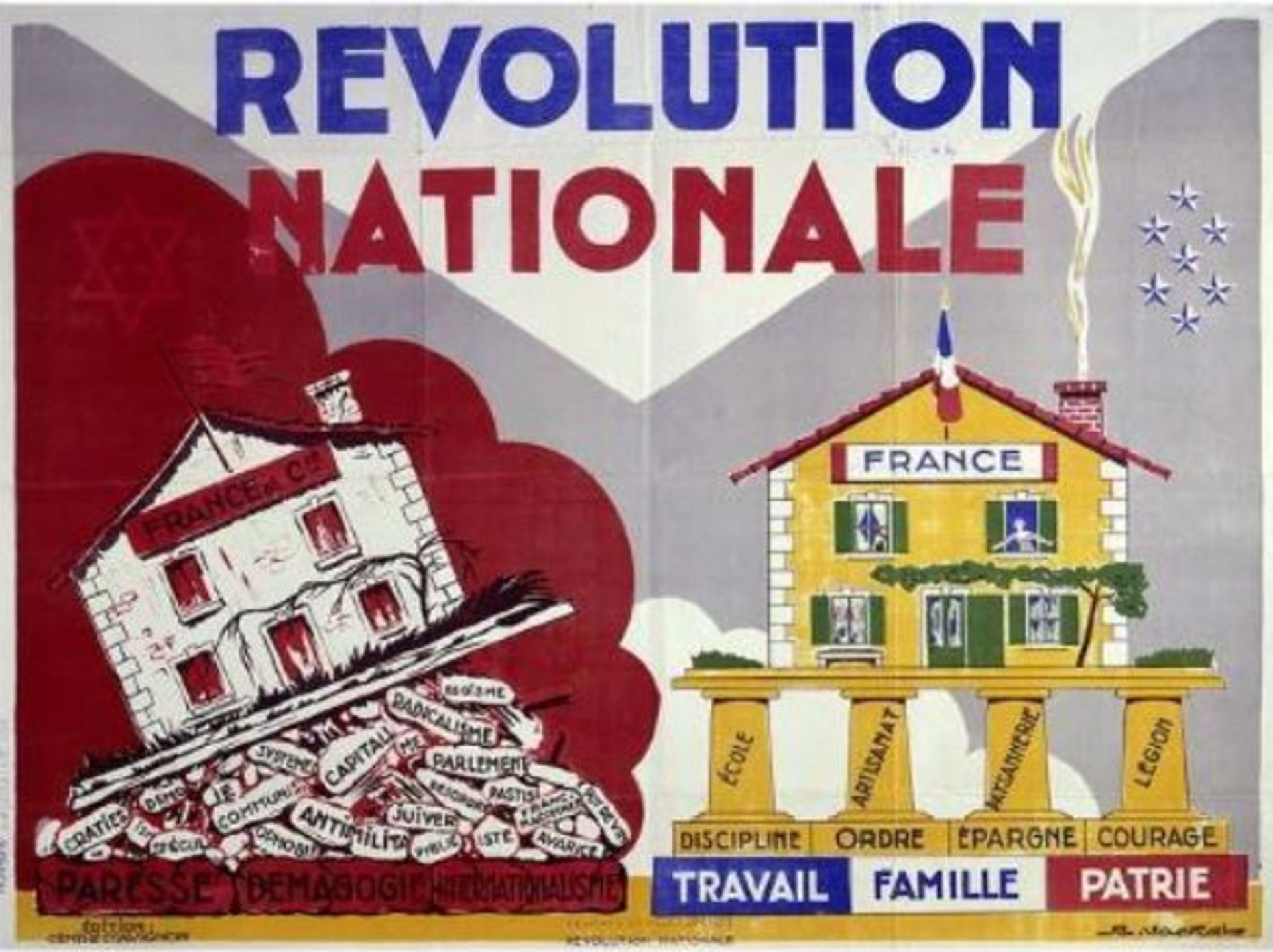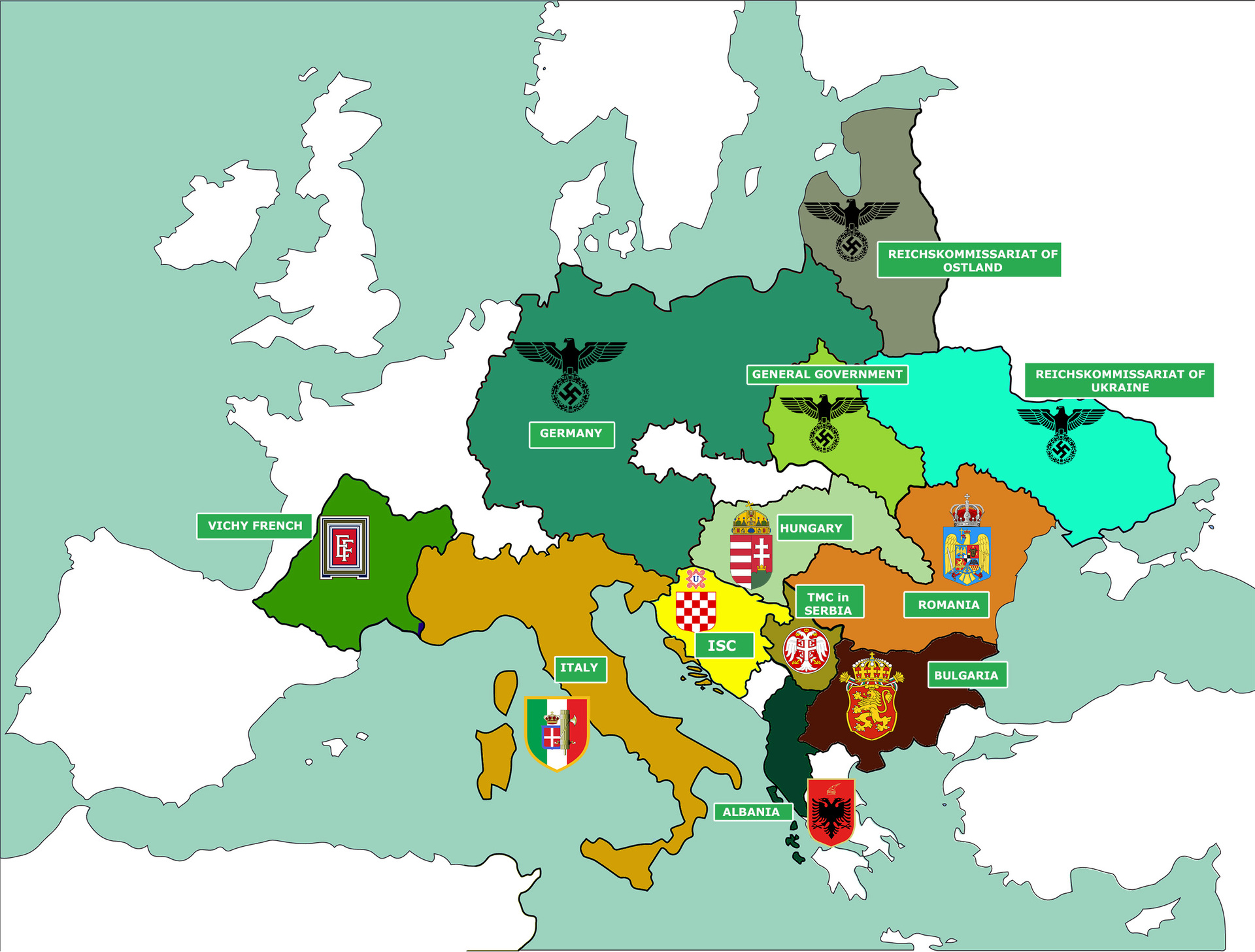European Championship 1942
The war in Europe began in September 1939 with the German attack on Poland and by mid-1941, nearly all European countries, except Great Britain, would be under direct military or civilian rule of Germany, or would be its protectorates. By the end of 1941 and with the creation of the battlefields on the Pacific and in Asia, the war became a world war.
Nazism in Germany, socialism/communism in the USSR and fascism in Italy represent political religions, i.e. a form of sacralization of politics. It is characterized by a government that demands complete acceptance of the dogma of official ideology, tries to enter all spheres of life and permeate every aspect of life of an individual and a community. It takes on characteristics of a religion such as, for example: holy books, holy teachings, saints, worshippers, inquisition (secret police), the motif of struggle between good and evil, the motif of salvation and recovery of honor, etc. Because of this, political religions usually persecuted and tried to replace existing religions. A political religion does not accept simultaneous existence of other political ideologies and movements, denies individual autonomy in a community, imputes the commitment of respecting its orders and participating in the political cult, and expounds violence as a legitimate weapon in the struggle against the enemy, and as an instrument of restoration. Political religions are more spiritual than political ideologies and come into being as an answer to the “crisis of meaning” in people, with the goal of creating paradise on this world.[1]
Western European politicians did not perceive Nazi Germany in the 1930s as a danger for the European order. Hitler did not dispute the order created on the west borders of Germany, but he demanded changes on the eastern borders, where it won the fight in World War I, which was not an absurd program. Hitler could, at the same time, come forward as the defender of capitalist Europe from communism.[2] No one reacted to the Anschluss, nor to the occupation of Czechia, and especially not to the German anti-Semitic laws and persecution of Jews.
Compared to, for example, the USA, it seemed clear in the 1930s that the USA were a democracy with certain freedoms, while Germany was a dictatorship that persecuted the Jewish minority, imprisoned dissidents no matter their religious beliefs, all the while proclaiming the supremacy of the Nordic “race”. However, observing anti-Semitism in Germany, African-Americans in the USA could not regard their situation as too different. In the end, USA joined England and France in pacifying Hitler.[3]
Even the most powerful institution in the history of humankind, the Catholic Church, was careful about criticizing Nazi politics. The primary goals of the pope and the Vatican before and during the War, a goal they adjusted their foreign policy and activities toward, were the struggle to maintain the institution of the Church and the fight against communism.[4] In comparison, any other regime was necessarily better. The reasons for this stance of the Catholic Church were clear. Aside from being a political religion itself, communism, in its theory, aspired to abandoning imaginary supports in the life of a human, and was, as such, incompatible with religious beliefs,[5] instead of which atheism was desirable. On the other hand, the Nazis tolerated the existence of the Church,[6] attacking politically active priests, but not the Christian religion as such.[7]
What weakened the decisiveness of French and British authorities was the memory of the bloody World War I, and another war like that needed to be avoided at all costs. Neither had anything to gain in a new war, but they had a lot to lose.[8]
Collaborationism did not necessarily mean treason of one’s own country. All collaborationists believed that German troops would bring about a New Order – one strong, peaceful and unique Europe.[9] During the war (and especially after it), the name of Norwegian Nazi politician Vidkun Quisling would become an accepted synonym for a traitor – a quisling -– denoting a puppet collaborationist government.[10] However, he saw British imperialism exploiting the coast of Norway, not German Nazism, as the main enemy, and he himself was convinced of the privileged status of Norway as the cradle of the Nordic race in the New World Order.[11] The problem in eastern Europe was much more complicated since the peoples there were subject to governments that the Germans removed and replaced with new “liberation” forces who, as time would tell, overshadowed the Nazis with their brutal dictatorships.[12]
For the Nazis, war was also a means of racial “cleansing of Europe” and creating a New World Order.[13] On the other hand, the governments that led the war against Hitler – Great Britain, USSR, and USA – did not represent something substantially different from Germany, something that would make their victory a blow to imperialism, racism, totalitarianism or militarism in the world. [14]
- [1] Tihomir Cipek, lecture at the course 'Political propaganda in totalitarian regimes'' (Postgraduate university doctoral study “Politology”), Faculty of Political Science, Zagreb, 18.XI. 2013.; Article on the book ''Zbornik Nikše Stančića'' '' http://www.historiografija.hr/prikazi.php?id=235959
- [2] Alan John Percivale TAYLOR, Uzroci Drugog svjetskog rata, Zagreb, 1994, 96
- [3] Howard Zinn, Narodna povijest SAD-a, Zagreb: VBZ 2012., 447
- [4] Hans Kung, Katolička crkva. Kratka povijest, Zagreb: Alfa 2007.,225
- [5] Esad ĆIMIĆ, Drama ateizacije. Religija, ateizam i odgoj, Sarajevo, 1971 , 108
- [6] Garry Wills, Papinski grijeh, Zagreb: Jesenski i Turk, 2015.,55
- [7] Tihomir Cipek, lecture at the course 'Political propaganda in totalitarian regimes'' (Postgraduate university doctoral study “Politology”), Faculty of Political Science, Zagreb, 18.XI. 2013
- [8] Eric J. HOBSBAWM, Doba ekstrema : kratko dvadeseto stoljeće 1914.-1991, Zagreb, 2009, 137-138
- [9] Alaster HAMILTON, Fašizam i intelektualci : 1919-1945., Beograd, 1978, 317
- [10] Grupa autora, Povijest: Prvi svjetski rat i poslijeratno doba (1914. - 1936.) , book XVI, Zagreb 2008, 518
- [11] Robert O.Paxton, Anatomija fašizma, Tim Press: Zagreb 2012., 116
- [12] Michael BURLEIGH, Treći Reich : nova povijest, Zaprešić, 2012, 530
- [13] Michael BURLEIGH, Treći Reich : nova povijest, Zaprešić, 2012, 711
- [14] Howard Zinn, Narodna povijest SAD-a, Zagreb: VBZ 2012,445

Sources
- Michael BURLEIGH, Treći Reich : nova povijest, Zaprešić, 2012.
- Tihomir Cipek, predavanje na kolegiju ''Politička propaganda u totalitarnim režimima'' (Poslijediplomski sveučilišni doktorski studij „Politologija“), Fakultet političkih znanosti, Zagreb, 18.XI.. 2013.
- Esad ĆIMIĆ, Drama ateizacije. Religija, ateizam i odgoj,, Sarajevo, 1971.
- Grupa autora, Povijest: Prvi svjetski rat i poslijeratno doba (1914. - 1936.) , knjiga XVI., Zagreb 2008.
- Alaster HAMILTON, Fašizam i intelektualci : 1919-1945., Beograd, 1978.
- Eric J. HOBSBAWM, Doba ekstrema : kratko dvadeseto stoljeće 1914.-1991, Zagreb, 2009.
- Hans Kung, Katolička crkva. Kratka povijest, Zagreb: Alfa 2007
- Robert O.Paxton, Anatomija fašizma, Tim Press: Zagreb 2012.
- Alan John Percivale TAYLOR, Uzroci Drugog svjetskog rata, Zagreb, 1994.
- Garry Wills, Papinski grijeh, Zagreb: Jesenski i Turk, 2015.
- Howard Zinn, Narodna povijest SAD-a, Zagreb: VBZ 2012
- ''Prikaz knjige ''Zbornik Nikše Stančića'' '' http://www.historiografija.hr/prikazi.php?id=235959
Poster ''Revolution Nationale'', https://www.reddit.com/r/PropagandaPosters/comments/2b5qdc/r%C3%A9volution_nationale_france_19401942/
